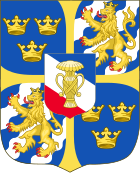Catherine Vasa of Sweden
This article cites its page references. (June 2020) ) |
| Catherine Vasa | |
|---|---|
Gustav I of Sweden | |
| Mother | Margaret Leijonhufvud |
| Swedish Royalty |
| House of Vasa |
|---|
 |
|
Gustav I |
|
| Eric XIV |
|
| John III |
| Sigismund |
| Charles IX |
|
| Gustavus Adolphus |
|
| Christina |
Catherine Vasa of Sweden (Swedish: Katarina Gustavsdotter Vasa; 6 June 1539 – 21 December 1610) was a Swedish princess, and the Countess consort of East Frisia as the spouse of Edzard II, Count of East Frisia. She was the oldest daughter of Gustav Vasa and Margareta Leijonhufvud. She was the autonomous Regent of Berum and Norden in Ostfriesland (East Frisia) from 1599 to 1610.[1]
Biography
Early life
During her early childhood, she, as well as her siblings in the royal nursery, were primarily under the care of her mother the queen's trusted nurse,
Edzard chose Catherine, but the negotiations took a long time, so much so that Gustav Vasa stated in his frustration that it was a blessing that his daughter was at least neither "limped or blind". Edzard's mother, the dowager Regent Anna of Oldenburg, was afraid that the marriage would lead to Swedish domination, and therefore split the power in Ostfriesland between her sons, something which the king tried to prevent.[3] In the marriage contract of 12 August 1558, Catherine was assured Berum and Norden as her dower lands and the post of Regent if Edzard should be succeeded by an underage son of hers.[3]
The wedding took place in Stockholm 1 October 1559. In November, Catherine and Edzard left for Ostfriesland. Upon their journey through Sweden, they were accompanied by her sister Cecilia and the brother of Edzard, John II of Osfriesland.[3] While staying in Vadstena on the way, a great scandal erupted when John was discovered in Cecilia's chamber without his trousers.[3] The scandal became famous under the name Vadstenabullret (The Vadstena Thunder).[3] John were imprisoned and Catherine and Edzard placed under guard in Västerås Castle. Catherine acted as mediator to execute a release of John, that Cecilia be treated leniently and to be given permission to leave.[3] The complications, her own pregnancy and the death of her father in 1560 caused the delay of their departure until 1561.
Countess of Ostfriesland
Catherine arrived in
In 1578, the childless John did agree that the son of Catherine should be his heir, but this did not end the struggle. Catherine fully used her family connections for her policy and asked her ruling brothers to intervene in her benefit, while she herself used her connections in return: she assisted Charles with his export- and import business, she provided ships for the Swedish fleet in the war against Russia, and assisted in the negotiations for marriages for Charles and Elizabeth.[3] She is known to have protested against the marriage of her brother King John III to Gunilla Bielke in 1585.[3] In 1591, Edzard became sole regent, but in 1594, the Emden revolution erupted. Catherine asked for the assistance of her brother Charles IX, who on this occasion advised her to show religious tolerance and expressed his surprise that it was always Catherine who seemed to handle the negotiations of the affairs of state rather than Edzard.[3]
Fiefholder
After the death of Edzard in 1599, Catherine lived at

Catherine is considered to be closest in character to her father among her siblings. She is described as intelligent and learned with an interest in literature and theology. She was a convinced Lutheran, visited Wittenberg to study theology, wrote interpretations of the bible, wrote an ode to Edzard at his funeral and was herself dedicated a work by a Lutheran theologian.[3]
Family
Catherine was married to
- Margaret of Ostfriesland (1560–1588)
- Julius Henry of Saxe-Lauenburg. She had no surviving issue from any of her marriages.
- Enno III of Ostfriesland(1563–1625)
- John III of Rietberg (1566–1625)
- Christopher of Ostfriesland (1569–1636)
- Edzard of Ostfriesland (1571–1572)
- Elizabeth of Ostfriesland (1572–1573)
- Sophia of Ostfriesland (1574–1630)
- Karl Otto of Ostfriesland (1577–1603)
- Maria of Ostfriesland (1582–1616); married Julius Ernst, Duke of Brunswick-Dannenberg and had issue.
Ancestors
| Ancestors of Catherine Vasa of Sweden | ||||||||||||||||||||||||||||||
|---|---|---|---|---|---|---|---|---|---|---|---|---|---|---|---|---|---|---|---|---|---|---|---|---|---|---|---|---|---|---|
| ||||||||||||||||||||||||||||||
References
- ^ "Stammbaum Archiv". Stammbaum Archiv. Retrieved 2023-02-13.
- ^ Tegenborg Falkdalen, Karin, Margareta Regina: vid Gustav Vasas sida : [en biografi över Margareta Leijonhufvud (1516-1551)], Setterblad, Stockholm, 2016
- ^ ISBN 978-91-85873-87-6(In Swedish)
- ^ "Stammbaum Archiv". Stammbaum Archiv. Retrieved 2023-02-13.
- Karin Tegenborg Falkdalen (2010). Vasadöttrarna (The Vasa Daughters). Falun: Historiska Media. ISBN 978-91-85873-87-6(In Swedish)
